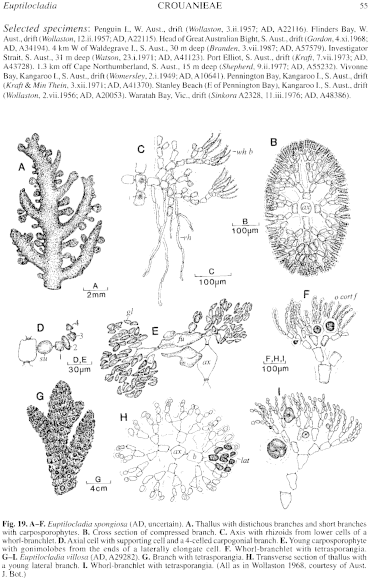|
|
|
|
|
|||||||||||
|
Electronic Flora of South Australia Species Fact Sheet
Phylum Rhodophyta – Order Ceramiales – Family Ceramiaceae – Tribe Crouanieae
Thallus (Fig. 18B) medium to dark red-brown, 5–15 cm high, spongiose, more or less alternately distichously branched, with a branched main axis and strongly developed lateral branches, branched for 4 or 5 orders, axes slightly compressed, 1–2 mm broad, decreasing gradually to lesser branches 0.3–1 mm broad; main branches with numerous short, distichous, terete laterals 1–3 (–4) mm long; branches largely covered by whorl-branchlets except near apices where axial cells are visible between the whorls; lower branches heavily corticate with coarse rhizoids. Holdfast conical, rhizoidal, 1–4 mm across; epilithic. Structure. Axes with small apical cells, subapical cells 12–22 µm in diameter and L/D 1–1.5, enlarging to 200–350 µm in diameter and L/D 1–2 in lower thallus, each cell with 4 whorl-branchlets (Fig. 19H), thick walled, two opposite longer ones (in the plane of thallus branching) 0.5–1mm and 7–11 cells long, subdichotomously branched 5–6 times with upwardly curved terminal rows of 3–7 cells, and 2 opposite shorter branchlets 250–500 µm and 5–6 cells long; basal cells of whorl-branchlets 60–90 µm in diameter and L/D 1.2–1.6, tapering to the terminal rows of short cells 14–22 µm in diameter and L/D 1–1.5. Lateral branches arise from the basal cells of whorl-branchlets and the axial cells become heavily corticated by entwined rhizoids 25–40 µm in diameter from inner cells of whorl-branchlets. Cells uninucleate; rhodoplasts elongate to ribbon like.
Reproduction: Procarps as in E. spongiosa, producing post-fertilization gonimolobes 200–500 µm across of ovoid carposporangia 16–25 µm in diameter, surrounded by whorl-branchlets in short determinate branches. Spermatangia unknown.
Tetrasporangia (Fig. 19G, I) sessile on mid and outer cells of whorl-branchlets, subspherical when mature, 80–130 µm in diameter, tetrahedrally divided.
Type from Robe, S. Aust., drift (Wollaston, 6.v.1965); holotype in AD, A29282.
Selected specimens: Elliston, S. Aust., 25 m deep outside bar (Shepherd, 25.x.1971; AD, A42577). Topgallant I., S. Aust., 35 m deep (Branden, 2.vii.1987; AD, A57549). Point Avoid, S. Aust., drift (Womersley, 2.xii.1975; AD, A46881). Port Elliot, S. Aust., drift (Parsons, 15.i.1968; AD, A32265). Middleton, S. Aust., drift (Womersley, 14.xi.1965; A29691). West Bay, Kangaroo I., S. Aust., drift (Womersley, 6.i.1946; AD, A3221). Seal Bay, Kangaroo I., S. Aust., drift (Womersley, 29.x.1966; AD, A31055). Pennington Bay, Kangaroo I., S. Aust., drift (Womersley, 28.i.1946; AD, A2822). Stanley Beach, Kangaroo I., S. Aust., drift (Wollaston, 2.vii.1956; AD, A29922). Stinky Bay, Nora Creina, S. Aust., drift (Parsons, 9.ii.1968; AD, A32230). 1.3 km off Cape Northumberland, S. Aust., 15 m deep (Shepherd, 26.x.1977; AD, A55335).
Distribution: Elliston to Cape Northumberland, S. Aust.
Taxonomic notes: E. villosa is very similar in habit to E. spongiosa but differs in the whorl-branchlets having longer cells in the terminal rows, and in having larger tetrasporangia.
References:
WOLLASTON, E.M. (1968).Morphology and taxonomy of southern Australian genera of Crouanieae Schmitz (Ceramiaceae, Rhodophyta). Aust. J. Bot. 16, 217–417.
The Marine Benthic Flora of Southern Australia Part IIIC complete list of references.
Publication:
Womersley, H.B.S. (24 December, 1998)
The Marine Benthic Flora of Southern Australia
Rhodophyta. Part IIIC. Ceramiales – Ceramiaceae, Dasyaceae
©State Herbarium of South Australia, Government of South Australia
Illustrations in Womersley Part IIIA, 1998: FIGS 18B, 19 G–I.

Figure 18 enlarge
Fig. 18. A. Euptilocladia spongiosa (AD, A27925). B. Euptilocladia villosa (AD, A29282). C. Ptilocladia pulchra (AD, A64756). D–F. Ptilocladia vestita (D, AD, A64750; E, F, AD, A37695). Habit of each species. E. Spennatangia on terminal cells of whorl-branchlets. F. Branch with tetrasporangia. (A, B, as in Wollaston 1968, courtesy of Aust. J. Bot.)

Figure 19 enlarge
Fig. 19. A–F. Euptilocladia spongiosa (AD, uncertain). A. Thallus with distichous branches and short branches with carposporophytes. B. Cross section of compressed branch. C. Axis with rhizoids from lower cells of a whorl-branchlet. D. Axial cell with supporting cell and a 4-celled carpogonial branch. E. Young carposporophyte with gonimolobes from the ends of a laterally elongate cell. F. Whorl-branchlet with tetrasporangia. G–I. Euptilocladia villosa (AD, A29282). G. Branch with tetrasporangia. H. Transverse section of thallus with a young lateral branch. I. Whorl-branchlet with tetrasporangia. (All as in Wollaston 1968, courtesy of Aust. J. Bot.)

|
Email Contact: State Herbarium of South Australia |

|